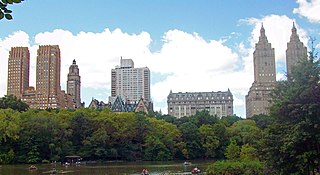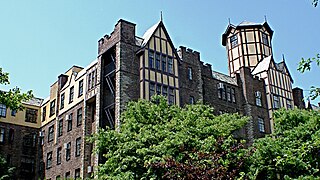
The Dakota, also known as the Dakota Apartments, is a cooperative apartment building at 1 West 72nd Street on the Upper West Side of Manhattan in New York City, United States. The Dakota was constructed between 1880 and 1884 in the German Renaissance style and was designed by Henry Janeway Hardenbergh for businessman Edward Cabot Clark. The building was one of the first large developments on the Upper West Side and is the oldest remaining luxury apartment building in New York City. The building is a National Historic Landmark and has been designated a city landmark by the New York City Landmarks Preservation Commission. The building is also a contributing property to the Central Park West Historic District.

Morningside Heights is a neighborhood on the West Side of Upper Manhattan in New York City. It is bounded by Morningside Drive to the east, 125th Street to the north, 110th Street to the south, and Riverside Drive to the west. Morningside Heights borders Central Harlem and Morningside Park to the east, Manhattanville to the north, the Manhattan Valley section of the Upper West Side to the south, and Riverside Park to the west. Broadway is the neighborhood's main thoroughfare, running north–south.

A housing cooperative, or housing co-op, is a legal entity, usually a cooperative or a corporation, which owns real estate, consisting of one or more residential buildings; it is one type of housing tenure. Typically housing cooperatives are owned by shareholders but in some cases they can be owned by a non-profit organization. They are a distinctive form of home ownership that have many characteristics that differ from other residential arrangements such as single family home ownership, condominiums and renting.

Astor Row is the name given to 28 row houses on the south side of West 130th Street, between Fifth and Lenox Avenues in the Harlem neighborhood of Manhattan, New York City, which were among the first speculative townhouses built in the area. Designed by Charles Buek, the houses were built between 1880 and 1883 in three spurts, on land John Jacob Astor had purchased in 1844 for $10,000. Astor's grandson, William Backhouse Astor, Jr., was the driving force behind the development.

The New York City Housing Authority (NYCHA) is a public development corporation which provides public housing in New York City, and is the largest public housing authority in North America. Created in 1934 as the first agency of its kind in the United States, it aims to provide decent, affordable housing for low- and moderate-income New Yorkers throughout the five boroughs of New York City. NYCHA also administers a citywide Section 8 Leased Housing Program in rental apartments. NYCHA developments include single and double family houses, apartment units, singular floors, and shared small building units, and commonly have large income disparities with their respective surrounding neighborhood or community. These developments, particularly those including large-scale apartment buildings, are often referred to in popular culture as "projects."

Hudson View Gardens is a cooperative apartment complex located on Pinehurst Avenue and Cabrini Boulevard in the near vicinity of West 183rd and 185th Streets, located in the Hudson Heights subsection of the Washington Heights neighborhood in Manhattan, New York City. It overlooks the Hudson River to the west and Bennett Park – which includes Manhattan's highest natural point – to the east. The complex was constructed as a housing cooperative from 1923 to 1925. In 2016 it was listed on the National Register of Historic Places.

Sugar Hill is a National Historic District in the Harlem and Hamilton Heights neighborhoods of Manhattan, New York City, bounded by West 155th Street to the north, West 145th Street to the south, Edgecombe Avenue to the east, and Amsterdam Avenue to the west. The equivalent New York City Historic Districts are:

The Majestic is a cooperative apartment building at 115 Central Park West, between 71st and 72nd Streets, adjacent to Central Park on the Upper West Side of Manhattan in New York City. It was constructed from 1930 to 1931 and was designed by the firm of Irwin S. Chanin in the Art Deco style. The Majestic is 30 stories tall, with twin towers rising from a 19-story base. The building is a contributing property to the Central Park West Historic District, a National Register of Historic Places–listed district, and is a New York City designated landmark.

The Harlem River Houses is a New York City Housing Authority public housing complex between 151st Street, 153rd Street, Macombs Place, and the Harlem River Drive in the Harlem neighborhood of Manhattan in New York City. The complex, which covers 9 acres (3.6 ha), was built in 1936-37 and opened in October 1937 – one of the first two housing projects in the city funded by the Federal government – with the goal of providing quality housing for working-class African Americans. It has 574 apartments.

Penn South, officially known as Mutual Redevelopment Houses and formerly Penn Station South, is a limited-equity housing cooperative development located between Eighth and Ninth Avenues and West 23rd and 29th Streets, in the Chelsea neighborhood of Manhattan in New York City. The complex has 2,820 units in ten 22-story buildings. Penn South is so named because of its location southwest of New York Penn Station.

555 Edgecombe Avenue is an apartment building at the southwest corner of Edgecombe Avenue and 160th Street in the Washington Heights neighborhood of Manhattan in New York City. It was originally known as the Roger Morris Apartments when it was built in 1914–16 – after the retired British Army officer who built the nearby Morris–Jumel Mansion – and was designed by Schwartz & Gross, who specialized in apartment buildings. The building was declared a National Historic Landmark under the name Paul Robeson Residence in 1976, and it became a New York City designated landmark in 1993.

The Matthew Henson Residence is a historic apartment residence at 246 West 150th Street in Manhattan, New York City. Apartment 3F in this building is where Matthew Henson (1866-1955), the African American polar explorer, lived from 1929 until his death. Henson was arguably the first man to reach the Geographic North Pole, a feat that is disputed in part by his own diary. His residence was named a National Historic Landmark in 1975.

First Houses is a public housing project in the East Village, Manhattan, New York City and was one of the first public housing projects in the United States. First Houses were designated a New York City Landmark and National Historic Landmark in 1974. They are managed by the New York City Housing Authority.

Graham Court is a historic apartment building in Harlem, Manhattan, New York City, along Adam Clayton Powell Jr. Boulevard between West 116th and 117th Streets. It was commissioned by William Waldorf Astor, designed by the architects Clinton and Russell, and constructed in 1899-1901 as part of the great Harlem real-estate boom.

The Dorilton is a luxury residential housing cooperative at 171 West 71st Street, at the northeast corner with Broadway, on the Upper West Side of Manhattan in New York City. The 12-story building, designed by local firm Janes & Leo in the Beaux-Arts style, was built between 1900 and 1902 for real estate developer Hamilton M. Weed. The Dorilton is a New York City designated landmark and is listed on the National Register of Historic Places.

United Workers Cooperatives, also known as Allerton Coops, is a historic apartment building complex located at 2700–2870 Bronx Park East in Allerton, Bronx, New York City. The complex includes three contributing buildings and five contributing structures. The Tudor Revival style buildings were built during two construction campaigns, 1926–1927 and 1927–1929 by the United Workers' Association. The buildings feature half timbered gables, horizontal half-timbered bands topped with sloping slate roofs, corbelled and crenellated towers, and picturesque chimneys.
Andrew Jackson Thomas (1875–1965) was a self-taught American architect who was known for designing low-cost apartment complexes that included green areas in the first half of the twentieth century.
The Queensboro Corporation was a real estate company founded by Edward A. MacDougall that played a major role in developing the Jackson Heights area of Queens, New York City.

The Rockefeller Apartments is a residential building at 17 West 54th Street and 24 West 55th Street in the Midtown Manhattan neighborhood of New York City. Designed by Wallace Harrison and J. André Fouilhoux in the International Style, the Rockefeller Apartments was constructed between 1935 and 1936. The complex was originally designed with 138 apartments.





















